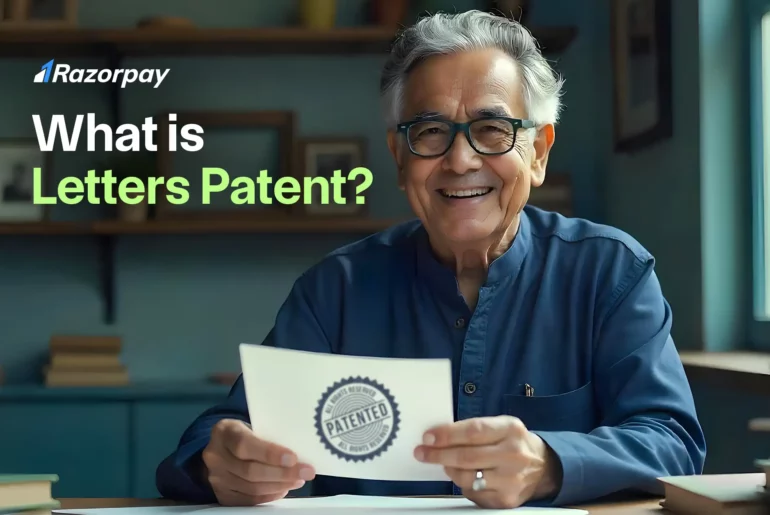Table of Contents
What is Letters Patent?
Letters patent are formal legal documents that grant specific rights, privileges and titles to individuals or entities that are issued by a governing authority such as a head of state, monarch or president, king, head of a corporation or by a government.
Read More About: What is a Patent?
Letters Patent Example
1. Establishment of High Courts
One of India’s most significant examples is the establishment of the High Courts of Calcutta, Bombay, and Madras through letters patent issued by King George IV. The Bombay High Court was established in 1823, providing a structured judicial system in the Bombay Presidency.
2. Allahabad High Court
The High Court of Judicature at Allahabad was established on March 17, 1866, replacing the Sudder Diwanny Adawlat. This was part of the broader restructuring of the judicial system in British India following the Government of India Act of 1858. The letters defined the new court’s jurisdiction and powers and appointed its first Chief Justice and judges.
3. Letters Patent Appeals
In contemporary legal practice, letters are often used in High Court appeals procedures. A party dissatisfied with a High Court judge’s decision may file a Letters Appeal to a larger bench within the same court. This process is essential for ensuring judicial oversight and addressing legal disputes.
The establishment of High Courts and the procedural framework for letters appeals demonstrate the diverse functions it has in the Indian legal system.
The Functions are as follows:
1. Judicial Structure
The establishment of High Courts by Letters Patent was key for establishing India’s formal judicial system, defining court jurisdictions and powers, and strengthening the rule of law.
2. Legal Recourse
The appeals emphasize the importance of judicial review, allowing scrutiny and modification of decisions to ensure checks and balances.
3. Historical Significance
It depicts the growth of India’s legal system from colonial times to an independent judiciary, adapting to modern legal needs.
Importance of Letters Patent
- Letters patent are crucial in the Indian legal framework, serving historical and contemporary roles.
- Historically, they were instrumental in establishing the judiciary during the British colonial period, as seen in the creation of High Courts in Bombay, Calcutta, and Madras, which laid the groundwork for a structured legal system.
- It continue to influence contemporary legal procedures, especially in appeals, where they support the values of justice and accountability in the legal system and ease judicial scrutiny.
- The importance of Letters Patent in the modern era extends to intellectual property rights, especially when it comes to patents.
- By giving them the sole right to their inventions, it empowers inventors and promotes economic expansion, innovation, and a healthy business environment.
Types of Letters Patents
There are various types of Letters Patent for various purposes such as conferring titles, appointing officers, constituting offices, granting rights or privileges, removing offices or officers etc
1. Conferring Titles
Nobility
Letters patent can be used to confer titles of nobility, such as duke, marquess, earl, baron, or knight.
Honorary Titles
They can also be used to bestow honorary titles, like Doctor of Letters (D.Litt.) or Doctor of Science (D.Sc.), upon individuals who have made significant contributions to their fields.
2. Appointing Officers
Government Positions
Letters patent can be used to appoint individuals to high-ranking government positions, such as ambassadors, judges, or governors.
Military Officers
They can also be used to commission military officers.
3. Constituting Offices
Creation of Offices
Letters patent can be used to create new government offices or positions.
Defining Responsibilities
They can also be used to define the duties and responsibilities of these offices.
4. Granting Rights or Privileges
Charters
Letters patent can be used to grant charters to corporations or institutions, giving them legal rights and privileges.
Patents
They can also be used to grant patents for inventions or discoveries, providing exclusive rights to the inventor or discoverer.
5. Removing Offices or Officers
Dismissal
In certain cases, letters patent can be used to remove individuals from government offices or positions.
Dissolution
They can also be used to dissolve government offices or institutions.
Related Read: What are the 4 Types of Patents in India?
Features of Letters Patent
1. Formal Authority
Letters patent are official documents issued by sovereign authorities, such as the President of India or the British Crown, granting enforceable rights and privileges.
2. Public Accessibility
They are open documents, allowing public access to understand the rights and privileges conferred and the jurisdiction of established institutions.
3. Jurisdictional Definition
They clearly define the jurisdiction and powers of courts or authorities, such as the original and appellate jurisdictions of High Courts.
4. Appointment of Officials
They outline appointed judges’ and officials’ roles and responsibilities, ensuring a structured judiciary.
5. Legal Recourse Mechanism
They facilitate appeals, allowing parties dissatisfied with a single judge’s decision to seek review by a larger bench.
6. Historical Significance
They represent the evolution of India’s legal system from colonial times to an independent judiciary, reflecting continuity and adaptation to modern needs.
7. Granting of Rights and Privileges
They provide special rights, including patents for inventions, promoting innovation and protecting intellectual property.
8. Revocation and Amendment Provisions
They can include provisions for revoking or amending rights and privileges, allowing adaptability to changing legal contexts.
Are Letters Patent Sealed or Issued?
In contrast to many other legal documents, letters patent are issued as public documents rather than being sealed. This transparency allows individuals and organisations to understand the rights and privileges granted, highlighting their role as accessible legal instruments.
Their non-sealed nature is essential for scrutiny and comprehension of their legal framework. This openness fosters trust in the legal system, enabling the public to access information about court jurisdictions, granted rights, and official appointments.
In India, the accessibility of letters patent is vital for maintaining judicial credibility and ensuring informed public participation in the legal system. Thus, the issued nature of letters patent reinforces accountability and transparency within the Indian legal framework.
What Are Letters Patent from the King or Queen?
The following points highlight the various functions and applications of letters patent:
1. Creation of Offices
They serve various functions, including the establishment of new offices within the government or judiciary.
2. Granting of Titles
They are often employed to confer noble titles or honors, such as knighthoods or baronetcies, recognizing individual achievements.
3. Conferral of Rights or Privileges
They can grant exclusive rights or privileges, including patents for inventions, allowing for economic development and innovation.
4. Official Declarations
They make official declarations that carry legal weight, ensuring clarity in legal processes and responsibilities.
5. Establishing Courts
A monarch may issue letters patent to create a new court, defining its jurisdiction and appointing judges, which ensures that the legal framework is clearly articulated and recognized.
6. Creation of Corporations
They are also used in the creation of corporations or granting city status, formalizing their legal standing.
Conclusion
Letters Patents are more than just historical legal frameworks, and they continue to have significant effects on modern India’s judiciary and intellectual property setting. These documents shaped the administration of law and justice, from establishing judicial entities such as the High Courts to award exclusive rights in innovation and appeals. Their ability to ensure transparency, authority, and rights protection demonstrates their long-term relevance in India’s legal and business environment.
Related Read: Types of Patent Applications in India
Frequently Asked Questions
1. Who issues letters patent?
Letters patent are issued by a sovereign power, such as the President of India or the British Crown, primarily used in forming High Courts and appointing judges, ensuring legal recognition of granted rights.
2. How many letters patent are there?
The number of letters patent varies by context; for instance, the UK has 92 types, while in India, the focus is on judicial nominations and High Court establishment.
3. What are letters patent used for?
Letters patent establish courts, appoint officials, and grant titles and rights, serving as formal declarations that confer specific powers and privileges.
4. What is the Letters Patent Act in India?
The Letters Patent Act in India outlines the framework for issuing letters patent, particularly concerning High Courts, defining their jurisdiction and powers to maintain the judiciary structure.
5. How do letters patent differ from other forms of intellectual property protection?
Letters patent grant exclusive rights to inventors for their inventions, differing from trademarks and copyrights, which protect brands and artistic works.
6. What are the legal requirements for obtaining a letters patent?
To obtain a letters patent, an applicant must submit a formal application detailing the innovation, which undergoes examination for compliance with legal requirements, and the grant must be made public.
7. What are the ethical considerations in obtaining a letters patent?
Ethical considerations include demonstrating that the innovation is novel and non-obvious, respecting previous patent holders’ rights, and avoiding misrepresentation during the application process.
8. Can you provide examples of famous inventions protected by letters patent?
Famous inventions protected by letters patent include Thomas Edison’s electric lightbulb and Alexander Graham Bell’s telephone, both of which significantly advanced technology and innovation.





